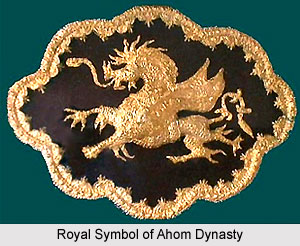 Jogeswar Singha was raised to the throne of Ahom kingdom by the Burmese in 1821 CE. The real administrative power was however with the Burmese and Jogeswar Singha merely acted as per their orders. During his reign, the Burmese atrocities were at height and Purandar Singha and Chandrakanta Singha made considerable attempts to dispose the Burmese invaders. The expulsion of Jogeswar Singha from the throne has contradictory accounts in which some historians say that he was expelled by Burmese masters and others say that he remained a puppet ruler till the end of Burmese rule over Assam. Jogeswar Singha was born to Bagakonwar Tipam Raja who in turn was a descendent of Charing Raja Jambar Gohain.
Jogeswar Singha was raised to the throne of Ahom kingdom by the Burmese in 1821 CE. The real administrative power was however with the Burmese and Jogeswar Singha merely acted as per their orders. During his reign, the Burmese atrocities were at height and Purandar Singha and Chandrakanta Singha made considerable attempts to dispose the Burmese invaders. The expulsion of Jogeswar Singha from the throne has contradictory accounts in which some historians say that he was expelled by Burmese masters and others say that he remained a puppet ruler till the end of Burmese rule over Assam. Jogeswar Singha was born to Bagakonwar Tipam Raja who in turn was a descendent of Charing Raja Jambar Gohain.
First Burmese Invasion
In the year 1815, the Prime Minister of Ahom kingdom, Purnananda Burhagohain, sent forces for the arrest of Badan Chandra Borphukan who was the Ahom viceroy and had the charge of committing atrocities over the folks of lower Assam. However he escaped to Bengal and there Badan Chandra teamed up with a Calcutta Agent of the Burmese government. He accompanied the agent to the court of Amarapura and with his misrepresentations, convinced the Burmese king, Bodawpaya, about misdeeds of Purnananda Burhagohain. In the year 1816 a huge army was dispatched from Burma, accompanied by Badan Chandra Borphukan. To oppose this, another army was sent by Purnananda Burhagohain which led to a battle at Ghiladhari. In the battle Purnananda Burhagohain died, whereas some historians say that he swallowed diamonds and committed suicide which left the Ahom army without any leaders. Later his son Ruchinath continued the leadership and battled against the Burmese. However the Burmese continued to proceed and captured the capital Jorhat. With his powers he also acquired the administrative powers from the then king Chandrakanta.
Badan Chandra and Chandrakanta Singha later entered into a treaty with the Burmese general. The Burmese general demanded from the Ahoms, the marriage of one of the Ahom princess and the Burmese monarch along with other gifts. For this, the sister of Jogeswar Singha, Hemo Aideo, was selected.
Second Burmese Invasion
During this time, political instability prevailed in the kingdom. Political rivals of Badan Chandra Borphukan assassinated him and this opportunity was seized by the son of Purnananda Burhagohain and he installed Purandar Singha on the throne by disposing Chandrakanta Singha. Chandrakanta Singha then mutilated the right ear of the king by making him ineligible for the throne and reached to the Burmese king for help. As the king had a treaty with Chandrakanta Singha, he immediately dispatched his army and defeated the army of Purandar Singha. Thus once again the Burmese installed Chandrakanta Singha on the throne.
Third Burmese Invasion
Eventually, Chandrakanta Singha tried to become free from the influence of Burmese and thus began strengthening his army against further invasion of Burmese. When the Burmese came to know about his intensions they approached towards the Assam borders and Chandrakanta Singha fled to Guwahati. When the Burmese officer invited him to the capital Jorhat, Chandrakanta Singha refused suspecting their intensions which led to an issue of mistrust. As revenge, the Burmese killed many Ahoms and Chandrakanta Singha reciprocated it by punishing the Burmese officers. When Burmese dispatched a huge army against him, he fled to the British who ruled in Bengal.
Succession of Throne
When Burmese fully captured the Ahom kingdom they appointed Jogeswar Singha, who was the eldest brother of Hemo Aideo, as the king. This served dual purpose. One was the augmentation of the prestige of Assamese queen Hemo Aideo and the other was to keep the Assamese subjects happy by choosing their native ruler for the kingdom. But in fact, Jogeswar Singha did not have any power as the king and all the powers lied in the hands of Burmese.
In late 1821 AD Chandrakanta Singha prepared his army to chase the Burmese and succeeded in capturing the north bank of Brahmaputra. The army consisted of Hindustanis and Sikhs from the British rule. This resulted into a conflict between the two troops and led to the battle of Mahgarh. The battle was however won by the Burmese owing to their large number. The final struggle of Chandrakanta Singha was traced in battle of Hadirachowki in which he was gravely defeated.
Death of Jogeswar Singha
After the defeat of Chandrakanta Singha, Burmese totally took over the administrative control and they appointed Mingimaha Kyaadeng Mogaton as the Governor of Assam. The social structure of Assam was considerably improved during this time. New officers were appointed and taxation system was introduced. It was during this time that Jogeswar Singha was disposed and was kept in confinement. Some other historians also state that he remained king till the expulsion of Burmese by British. Later, Jogeswar Singha arrived at Jogighopa under the escort of British. After his arrival he fell ill and eventually died in 1825 CE.



















